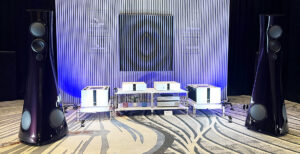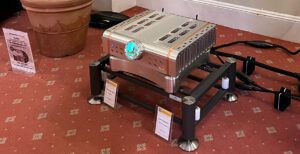
The absolute sound – the ethos, rather than our stable-mate – can be paired down to attempting to recreate the sound of live, unamplified music in a natural acoustic environment. This remains a valued goal of high-end audio, and a good method by which to assess audio equipment. The alternatives – either striving to choose products that ‘sound good’ with no benchmark to hold against that ‘good’, or an over-reliance on how a product measures – can create systems that are frequently ultimately unsatisfying.
However, the absolute sound ethos can tip over into dogma. Where it should be a useful tool in the audio assessment arsenal, its importance can be exaggerated to make it the only form of audio evaluation. Curiously, this can work against the end result of making live, unamplified sound more like the real thing.
Any loudspeaker system purporting to deliver full-range (or even close to full-range) sound is very likely to be tested with music that features plenty of deep bass. In orchestral music, this means something with tympani, or it may mean organ pedal tones, the far left hand of a piano or an upright bass. This is an obvious and correct thing to do: if you are about to invest in loudspeakers that do bass, you want to assess them with… bass.
The idea of using electronic dance music bass in that assessment runs counter to the ideals of the absolute sound; it’s electronic, and can therefore never fit into that ‘live, unamplified’ category (and why we are unlikely to see Kraftwerk do MTV Unplugged). If the synthesised sound is ‘DI’ (direct injection), the first time the sound gets heard is in the control room, so there’s no real-world frame of reference. However, synthesised bass does have unique properties, in that it can have an envelope (attack, decay, sustain and release) far more abrupt than any unamplified instrument. It can also be delivered with fast, metronome-like precision, something no percussionist, organ player or drummer could hope to achieve. An ideal example of this is ‘Chameleon’ from The Last Resort album by the Danish electronic music producer Anders Trentemøller. This track has a deep, repetitive and fast beat, with several occasional harmonics that reach into the low 20Hz region. These bass notes are very precisely shaped to have only slightly more attack and decay than a click track.
This is relevant because when played on a large ported loudspeaker, the ‘chuff’ of the port ends up extending the sustain of the beat, making it sound like a blurred, rolling bass than the precise start-stop beat. This is relevant because when you play the same on an infinite baffle design (or a well-designed transmission line), this rolling bass becomes a tight start-stop beat again. This is relevant because once you recognise it, you realise this applies throughout and you begin to realise that we make accommodations for instruments like timpani sounding entirely unlike the way they do in the real world, because we have become used to that rolling bass sound.
You can try this with ported loudspeakers and headphones. Once you begin to spot this bass ‘blur’, your perceptions on bass might just begin to change. But, the only way you can experience this is to try it, and try it on electronic music, which runs counter to the absolute sound ethos. Are you prepared to give it a try?
Tags: FEATURED
By Alan Sircom
More articles from this authorRead Next From Blog
See all
AXPONA 2024 Show Report Part One
- Apr 19, 2024

Audio Show Deluxe 2024: A photo show report
- Mar 28, 2024

Paul Messenger 1949-2024: A personal tribute
- Mar 26, 2024

Bristol Hi-Fi Show 2024: See You There!
- Feb 21, 2024










